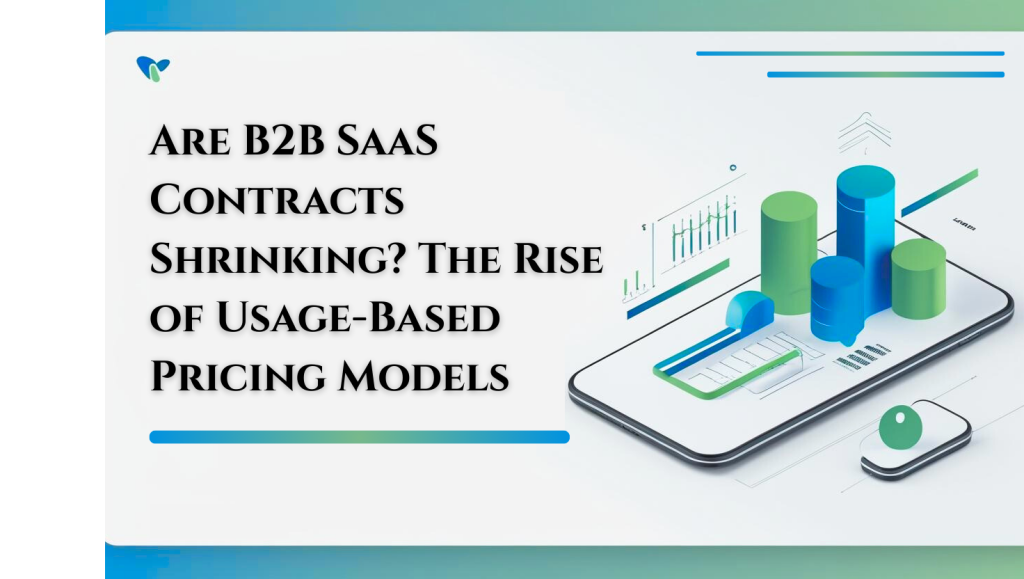Traditional SaaS Contracts Are Losing Ground –
For years, long-term contracts were the foundation of B2B SaaS. Vendors would lock customers into 12- to 36-month agreements with fixed pricing, predictable billing, and promised support. These contracts helped companies forecast revenue and scale predictably, especially in investor-driven environments. However, in 2025, that model is quickly becoming outdated.
Buyers are demanding flexibility. They want to test software before committing. They want to pay only for what they use. And most importantly, they want pricing models that reflect the real value they receive — not inflated feature sets they may never touch. Traditional contracts are increasingly seen as rigid, risk-heavy, and vendor-centric.
Why Usage-Based Pricing Is Taking Over –
The usage-based pricing (UBP) model — also known as pay-as-you-go or consumption-based pricing — is not new, but it’s spreading rapidly across the B2B SaaS ecosystem. Companies like AWS, Twilio, Snowflake, and Datadog have used UBP successfully for years, and now, mid-sized and even enterprise SaaS providers are following suit.
This model allows customers to start small, explore the product with minimal risk, and grow their spending naturally as their usage and value increases. For software companies, it aligns revenue more closely with customer success. When customers win, vendors earn more. When usage drops, so does the cost — and that transparency builds trust.
UBP also complements product-led growth strategies. Rather than relying on heavy sales processes and contracts, vendors can let the product do the work: users try it, use it, and expand their usage organically over time.
Market Forces Driving the Shift –
Several external forces are accelerating the shift to usage-based models in 2025. First, macroeconomic uncertainty is driving CFOs and procurement teams to scrutinize spending more than ever before. They want agility, not lock-in. UBP offers the ability to scale back in tough times and ramp up when needed — without renegotiating contracts or eating sunk costs.
Second, the rise of remote-first, digitally native buying teams has transformed the B2B purchase journey. Today’s buyers prefer to self-educate, test products hands-on, and avoid sales reps where possible. In this self-serve world, flexible pricing is a competitive edge.
Third, advanced analytics and billing infrastructure have made it easier than ever to track real-time usage. In the past, UBP was difficult to implement at scale due to tracking and billing complexity. Now, with tools like Metronome, Stripe Billing, and Chargebee, SaaS vendors can automate and scale usage-based pricing models reliably.
Benefits for Both Buyers and Vendors –
Usage-based pricing creates a win-win dynamic — when done right. Customers appreciate the low-risk entry point, the ability to scale gradually, and the transparency of paying only for what they use. This lowers the barrier to entry and reduces the friction often found in traditional SaaS sales cycles.
For vendors, UBP can unlock massive upside. It encourages product adoption, incentivizes continuous value delivery, and supports a natural expansion motion within accounts. Rather than focusing on renewals and upsells through human intervention, companies can grow accounts by simply improving the product and letting customers use more.
That said, it’s not without challenges. Revenue predictability can become more volatile, especially in early-stage companies. Sales teams must adjust their approach — moving from selling contracts to selling outcomes. And support and product teams must ensure that users quickly reach “value moments” that justify continued use.
The Rise of Hybrid Pricing Models –
Despite the growing popularity of UBP, very few SaaS companies are going all-in immediately. Instead, many are adopting hybrid models that combine the predictability of subscriptions with the flexibility of usage. These models offer the best of both worlds: a base fee for platform access, with variable pricing layered on top based on consumption.
Hybrid models are especially useful for companies transitioning from traditional contracts. They allow vendors to preserve some revenue stability while adapting to market demand for flexibility. For enterprise buyers, they offer optionality — with clear ceilings and floors for budgeting.
Examples include:
- Minimum monthly commitment + usage overage
- Flat platform fee + pay-per-feature usage
- Tiered usage buckets based on consumption thresholds
- Freemium access with usage-based scaling
Conclusion –
The shift away from long-term, fixed contracts toward usage-based pricing is not just a pricing evolution — it’s a business model transformation. In 2025, the most successful SaaS companies are not those that can lock customers in, but those that empower them to grow freely.
Usage-based pricing reflects a more honest, customer-centric approach to software sales. It forces vendors to focus on delivering continuous value. It aligns incentives between buyers and sellers. And most importantly, it mirrors the flexible, dynamic way modern businesses operate today.
For SaaS companies still holding onto legacy pricing structures, the message is clear: adapt or be disrupted. Flexibility, transparency, and customer-aligned pricing are no longer optional. They are the new normal.

